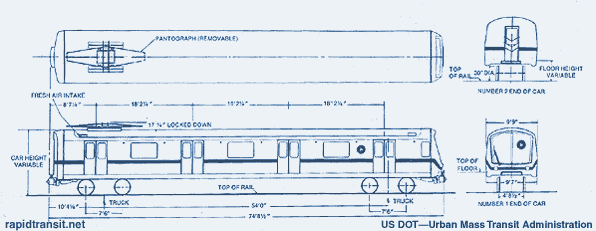
SOAC--
The State
of the Art Car
in Brooklyn
Page
2

The Traveler, showing something of his displacement to
suburbia, stepped into the second car, more sumptuously outfitted for
suburban-style service. if he was spoiled by the more genteel conditions
on the modern LIRR equipment (compared to the familiar rush hour crowding
of the subways) SOAC's design and colors carried it a step further. On the
seat-of-the-future was a souvenir brochure for the entering rider. As the
seat cushions were soft The Traveler and his companions snatched up the
mementos of the occasion. (On the modern New York subway cars the seats
are vandal- resistant hard, and a brochure or newspaper commonly serves as
a cushion; on SOAC vandal-resistance was provided by a transit
policeman.)
SOAC floats! Ten years earlier The Traveler would leave
Brighton Beach on the Triplex (D-type cars), whose roar was amplified by
the heavy elevated structure. Now there was a train-powerful! Equipment
which could have only gone into regular passenger service in 1927, the
year Babe Ruth hit 60 homers. Now they were gone, and no less than six
different types of modern subway car have operated out of Brighton Beach
in the ensuing ten years, But SOAC, with strong, smooth, acceleration,
floats.
There is a tendency to rock—probably more due to the
roadbed than the equipment, which is also the reason that the cars (like
the latest R-44 subway cars), capable of speeds up to 80 miles per hour,
do not exceed the system-wide limit of 50 m.p.h.
By Kings Highway (two stops down the line) SOAC is
full. The Traveler supposes that even in the future there will be
standees--welcome to the future. But the present standees don't seem to
mind. They are too busy paying mind to a riding experience they are
evidently enjoying. As a man from Boeing Vertol intones a welcome and an
inspirational message the passengers are actually smiling (like the time
the conductor caught the Christmas spirit a few years earlier and used the
p.a. system at each stop to wish all a Merry Christmas-even the most
hardened, subway worn face broke into a smile every time he did
it).
"Isn't it beautiful,"
comments one. "This is nice, isn't it," a matronly lady inquires of her
companion, and The Traveler thinks of another "first ride" he took several
years ago, soon after PATCO had opened its modern, successful Lindenwold
Line. At that time, too, he observed a trainload of happy, interested
passengers-but those were people who had previously depended on auto or
bus for their daily commuting. Rapid transit for them had been vague
second-hand stories of tie-ups and frustration in New York. One happy
group on that trip—mother, father and two children—didn't feel right about
leaving until the family walked up to the motorman's console and the
delighted young mother leaned forward and said, "thank you for a wonderful
train ride." That comment from the young, supposedly "car-oriented"
generation, and the similar reaction from the SOAC riders make you realize
that rail rapid transit is the "new car" of the seventies and eighties.
That interest and attention once lavished on the new car as
it sat in the family driveway in a fading era now goes
to the transportation to serve our future. If only the
majority in the nation who have no choice could see what
rapid transit can be Iike.
© 2000 by The Composing Stack Inc. Not responsible for typographical errors.
The Third Rail and The Third Rail logo are trademarks of The Composing Stack Inc.
Return to The Third Rail Online Home
Return to
rapidtransit.net Home
Everything on this site is copyright © 2000 by The Composing
Stack Inc., except as otherwise noted.
Materials
with other copyrights are used by permission.
All
rights reserved
Last updated